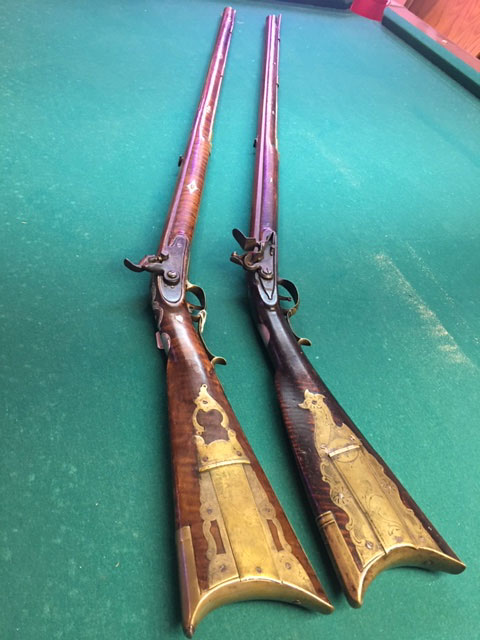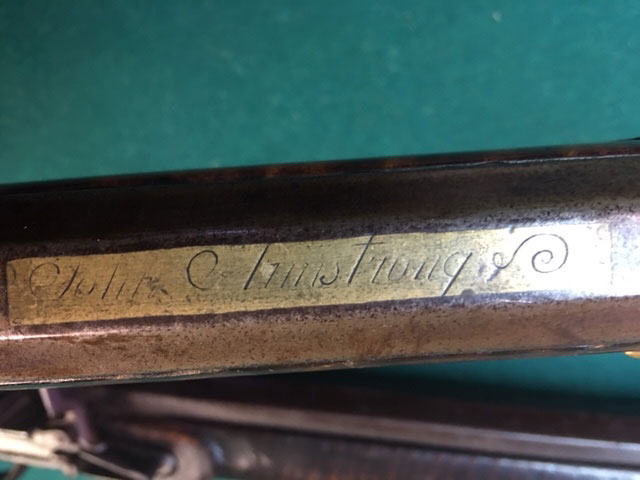James Rada, Jr.

Over its history, Emmitsburg has been home to artisans and craftsmen whose pride of craftsmanship made their work collector’s items. One notorious artisan of Emmitsburg is John Armstrong. He is known for crafting Armstrong rifles.
John Armstrong was a first-generation American, born in Liberty Township, Pennsylvania on September 5, 1772. It is believed that he apprenticed with a riflemaker in Hanover, Pennsylvania, when he was just 14.
He moved to Emmitsburg in 1793 and began making rifles. He was already listed as a head of his own household in 1790, which is unusual since most apprentices serve until they are 21, which is how old he would have been when he moved to Emmitsburg.
It is worth noting that Emmitsburg had two other young riflemakers—George Nunemaker I and Peter White—working in town during Armstrong’s early years in town.
“All three of these men were underage to have been working as independent gunsmiths and at no other place in the state can one find three craftsmen of this caliber working together,” Daniel D. Hartzler wrote in his article, “The Armstrong Boys of Emmitsburg.”
Armstrong started crafting his variation of the Kentucky Long Rifle by 1808, although some historians believe he was making them soon after he arrived in Emmitsburg.
He worked in iron, maple, brass, and silver. Many of his designs and design elements were adopted by other riflemakers “from the dove tail iron inset in the heel of the brass butt plate to the long-nosed muzzle cap,” Hartzler wrote.
The Rock Island Auction Company website says Armstrong “is generally considered to be one of the very best of the era. His pieces often draw comparisons to Swiss watches and Rolls Royce automobiles—classics that defy time.”
He taught a generation of gunsmiths, so much so he and his apprentices were known as the “Emmitsburg School of Gunsmiths.” He had three recorded apprentices and some that are known but not recorded.
His three recorded apprentices were Marine Tyler Wickham, George Piper, and John Blackburn. After their apprenticeships, they continued their work in Harpers Ferry, West Virginia; York, Pennsylvania; and Hagerstown, Maryland respectively. Nathaniel Rowe is also known to have apprenticed with Armstrong.
“The point is that John developed a style early in his career, in the late 18th century, that pleased him and pleased his customers; he did not change that basic design with the passage of time,” Albert Manley Sullivan wrote in Emmitsburg: History and Society.

Armstrong was a perfectionist who crafted all of the parts for his rifles, even though it took more time. “But none of these suited Armstrong. Not John Armstrong, the perfectionist! The store-bought locks were not good enough to go on his excellent products, so he made his own locks. Locks of a quality compatible with the high quality of everything else on his truly excellent rifles,” Sullivan wrote.
The result of making them himself was worth it. Sullivan described the locks as “slender, graceful and beautifully proportioned. They blend perfectly into the architectural balance of the gun.”
Like any artist, Armstrong signed his locks. An Armstrong rifle without a signed lock is not worth nearly as much.
His rifles, as you can see from the pictures included with this article, could be considered works of art. They have sold at auction from $40,000 to $90,000.
Armstrong’s four sons—William, Robert, Samuel, and James—were all trained as gunsmiths, although little information is available about them. It is known that William became the Master Armorer at the Marine Barracks in Washington, D.C. A rifle made by Samuel and another by Robert have also been found.
Given the time that Armstrong lived in Emmitsburg, and the size of the town, it shouldn’t be surprising that he knew Mother Elizabeth Seton. Armstrong did work for her, but not as a riflemaker. His name appears in her receipt book, showing that he did work for her and the Sisters of Charity, making locks, mending keys, repairing guitar screws, and repairing piano keys.
Current Emmitsburg Town staff members have talked about developing Emmitsburg’s cultural heritage in the past; recently, the town commissioners approved the creation and placement of three waysides in town that highlight different historical aspects of the town. Ruth Bielobocky of Ion Design Firm designed the waysides, and Scott Grove of Grove Public Relations wrote the copy. The three waysides will be at the Emmit House, doughboy statue, and town square. The Maryland Heritage Area Authority funded the project with a $9,000 grant.

